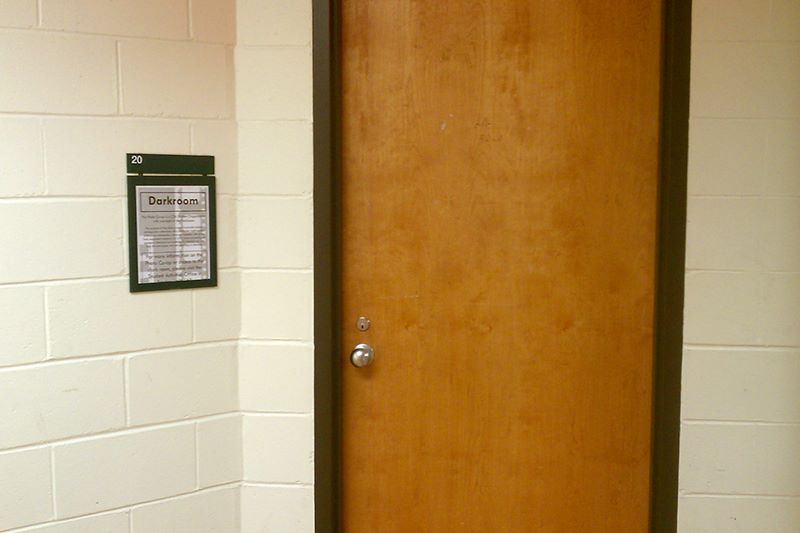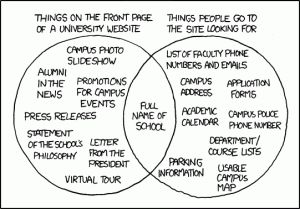Carleton has had a second wind turbine up for a while. I spent a little time today finding a place I could see them both from. Haven’t yet found a place I can see them both from plus have a good view of recognizable Carleton landmarks, but I may yet.
Tag: Carleton
Photo Co-op Darkroom
Back in the early 70s, I helped build the first version of the photo co-op darkroom in the basement of Sayles-Hill Gymnasium at Carleton.
I discovered tonight, while I was at the Career Center also in that basement, that there’s still a photo co-op darkroom there. Came close to getting to see the inside; one of the students I was talking to (about careers in computers) was a member of the photo co-op.
We went to get the key, but it had been checked out since April 29, and nobody was actually in the darkroom. I understand the darkroom is now used somewhat less than it used to be.
From what I can remember, I think maybe it’s in the same place it used to be. I wonder what it’s like inside these days?

Photo Expeditions
Last month, Ctein and I made a photo expedition that hit two destinations.
First we went to Minneopa State Park, which had nice waterfalls but poor foliage.
I keep going back to the Carleton campus. It’s a place I’ve known since I was 6, and have always liked. So that’s where we headed in hopes of better foliage (the maps showed it less advanced to the east).

Art vs. Reality (XKCD on University web sites)
Today’s XKCD cartoon seems to have hit pretty accurately. (If you’re not familiar with XKCD, it’s brilliant surprisingly often and very good most of the rest of the time.)

Mark Gritter had the idea of analyzing his school’s homepage.
So I’m going to analyze Carleton’s.

Present:
- Campus photo slideshow — right there on homepage, with popup labels; also “campus photos” link
- Alumni in the news — not linked from front page (they’re in “Carleton in the Media” which is linked from “Carleton News”)
- Promotions for campus events — Calendar on the front page
- Press releases — “News and Stories from Carleton” on the front page
- Statement of the school’s philosophy — no direct link
- Letter from the president — no direct link
- Virtual tour — no direct link
- Full name of school — yep
I score that 4/8 (I’m not scoring #2).
Things people look for:
- List of faculty phone numbers and emails — “Faculty and Staff” link then “Campus Directory”.
- Campus address — “Mailing address” link
- Applications forms — “Prospective student” / “Apply”
- Academic calendar — “Academics” / “Academic calendar”
- Campus police phone number — no (search reveals that the campus security emergency number is 4444)
- Department/course lists — “Academics” gives list of departments, clicking through gets a department homepage with “courses” link
- Parking information — no
- Usable campus map — “Maps and directions” link, then “Interactive campus map”; it’s Google-powered, and names the buildings, and looks accurate
- Full name of school — yep
I score 7/9 (I’m counting things that are indirect links but the chain is “obvious”; obviously this is subjective).
So, not nearly as bad as one might expect; Carleton actually has a higher proportion of the things people look for than they do of the things XKCD lists as always present.
The emergency number is something I never would have thought of, and is probably a good idea. The page does give the main switchboard number. When I was there that was staffed 24 hours a day, but I don’t think it is any more. And it needs to give the external number for emergencies, since people finding that from the web site will mostly be calling from their cell phones. Carleton would never call it the “campus police”, of course.
I’m tempted to snottily say that there’s no parking information because Carleton doesn’t allow parking—but in fact they’ve built a lot of parking lots since I was there, though still not nearly enough for student cars to be common. It’s not in a crowded metro area, and most of the time you can just park on the street fairly close, and the rest of the time you have to park on the street further away; but it should explain that somewhere, and I didn’t find it, even in the “travel by car” section of the campus visits page.
This iteration of the Carleton site is actually pretty decent.
Perpetuating the Data — Carleton Costs
Since he implies the information wasn’t online (or at least he didn’t get it from online), I’m going to post this so it’s there to be found.
These are “comprehensive fees”, meaning tuition plus room and board for a full-time student, meaning 9 months of the year. In addition to this, you would have had to buy textbooks, clothing, paper and typewriter ribbons and pens, and transportation to wherever you spent the summer. Plus living expenses for the summer (most people got summer jobs to pay for that and save to cover some of the year). Plus anything beyond absolute necessities you were going to have, like stereo systems and records and cameras and film and going to science fiction conventions. Or taking dates to dinner. Or whatever.
So, here’s the inflation of college tuition form 1972-2009 as viewed narrowly at Carleton College. This information came from the college archivist in response to a query I posted on the alumni email list. I attended Carleton 1972-77 (with some time off in 74-75).
Not from online, but by going back to the printed catalogs:
[edited to add 58/59 and 62/63 numbers from a later email]
1958/59:Â $1,700
1962/63:Â $2,250
1972/73: $3,825
1973/74: $4,000
1974/75: $4,200
1975/76: $4,600
1976/77: $4,900
1977/78: $5,277
1978/79: $5,725
1979/80: $6,175
1980/81: $6,940
1981/82: $7,980
1982/83: $9,260
1983/84: $10,200
1984/85: $10,900
1985/86: $11,880
1986/87: $12,800
1987/88: $13,640
1988/89: $15,230
1989/90: $16,950
1990/91: $18,250
1991/92: $19,620
1992/93: $20,900
1993/94: $22,155
1994/95: $23,375
1995/96: $24,425
1996/97: $25,410
1997/98: $26,325
1998/99: $27,195
1999/00: $28,230
2000/01: $29,340
2001/02: $30,780
2002/03: $32,445
2003/04: $34,395
2004/05: $36,975
2005/06: $40,467
2006/07: $42,864
2007/08: $45,645
2008/09: $48,039
2009/10: $50,205
Eric Hillemann
College Archivist

